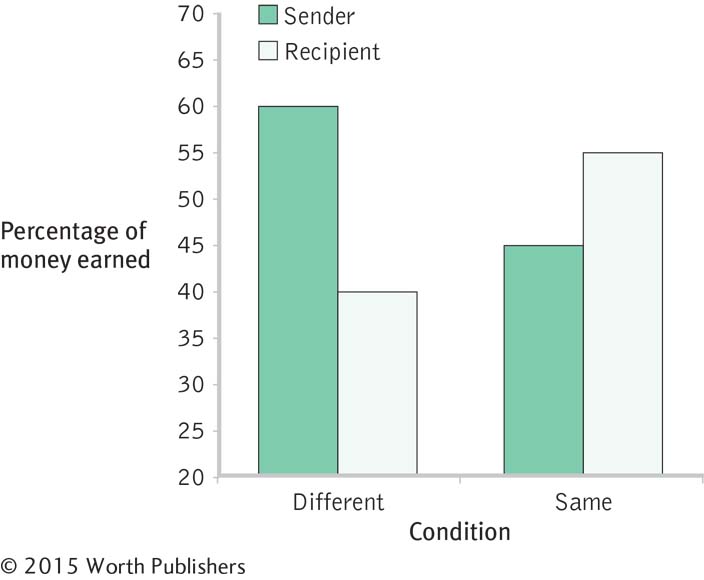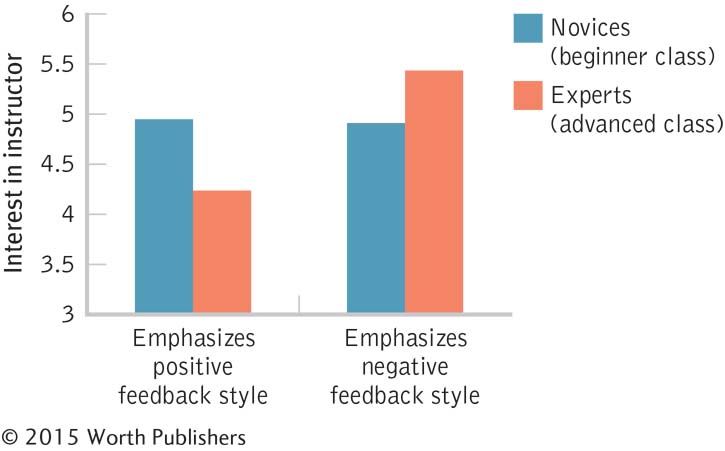Exercises
Clarifying the Concepts
Question 12.1
| 12.1 |
What is a two- |
Question 12.2
| 12.2 |
What is a factor? |
Question 12.3
| 12.3 |
In your own words, define the word cell, first as you would use it in everyday conversation and then as a statistician would use it. |
Question 12.4
| 12.4 |
What is a four- |
Question 12.5
| 12.5 |
What is the difference in information provided when we say two- |
Question 12.6
| 12.6 |
What are the three different F statistics in a two- |
Question 12.7
| 12.7 |
What is a marginal mean? |
Question 12.8
| 12.8 |
What are the three ways to identify a statistically significant interaction? |
Question 12.9
| 12.9 |
How do bar graphs help us identify and interpret interactions? Explain how adding lines to the bar graph can help. |
Question 12.10
| 12.10 |
How do we calculate the between- |
Question 12.11
| 12.11 |
In step 6 of hypothesis testing for a two- |
Question 12.12
| 12.12 |
When are post hoc tests needed for a two- |
Question 12.13
| 12.13 |
Explain the following formula in your own words: SSinteraction = SStotal − (SSrows + SScolumns + SSwithin). |
Question 12.14
| 12.14 |
In your own words, define the word interaction, first as you would use it in everyday conversation and then as a statistician would use it. |
Question 12.15
| 12.15 |
What effect- |
Calculating the Statistics
Question 12.16
| 12.16 |
For each of the following scenarios, what are two names for the ANOVA that would be conducted to analyze the data?
|
Question 12.17
| 12.17 |
Identify the factors and their levels in the following research designs.
|
Question 12.18
| 12.18 |
State how many cells there should be for each of these studies. Then, create an empty grid to represent those cells.
|
Question 12.19
| 12.19 |
Use these “enjoyment” data to perform the following:
|
357
Question 12.20
| 12.20 |
Use these data— “Dry” campus, state school: 47, 52, 27, 50 “Dry” campus, private school: 25, 33, 31 “Wet” campus, state school: 77, 61, 55, 48 “Wet” campus, private school: 52, 68, 60
|
Question 12.21
| 12.21 |
Using what you know about the expanded source table, fill in the missing values in the table shown here:
|
Question 12.22
| 12.22 |
Using the information in the source table provided here, compute R2 values for each effect. Using Cohen’s conventions, explain what these values mean.
|
Question 12.23
| 12.23 |
Using the information in the source table provided here, compute R2 values for each effect. Using Cohen’s conventions, explain what these values mean.
|
Applying the Concepts
Question 12.24
| 12.24 |
Football, eye glare, and ANOVA: In Exercise 11.67 (page 322), we described a Yale University study. Let’s consider a redesign in which researchers randomly assigned 46 participants to place one of three substances below their eyes: black grease, black antiglare stickers, or petroleum jelly. They assessed eye glare using a contrast chart that gives a value for each participant, a scale measure. Black grease led to a reduction in glare compared with the two other conditions, antiglare stickers or petroleum jelly (DeBroff & Pahk, 2003). Imagine that every participant was tested twice, once in broad daylight and again under the artificial lights used at night.
|
Question 12.25
| 12.25 |
Health-
|
Question 12.26
| 12.26 |
Memory and choosing the type of ANOVA: In a fictional study, a cognitive psychologist studied memory for names after a group activity. The researcher randomly assigned 120 participants to one of three conditions: (1) group members introduced themselves once, (2) group members were introduced by the experimenter and by themselves, and (3) group members were introduced by the experimenter and themselves, and they wore name tags throughout the group activity.
|
358
Question 12.27
| 12.27 |
Age, online dating, and choosing the type of ANOVA: A researcher wondered about the degree to which age was a factor for those posting personal ads on Match.com. He randomly selected 200 ads and examined data about the posters (the people who posted the ads). Specifically, for each ad, he calculated the difference between the poster’s age and the oldest acceptable age in a romantic prospect. So, if someone were 23 years old and would date someone as old as 30, his or her score would be 7; if someone were 25 and would date someone as old as 23, his or her score would be −2. The researcher then categorized the scores into male versus female and seeking a same-
|
Question 12.28
| 12.28 |
Racism, juries, and interactions: In a study of racism, Nail, Harton, and Decker (2003) had participants read a scenario in which a police officer assaulted a motorist. Half the participants read about an African American officer who assaulted a European American motorist, and half read about a European American officer who assaulted an African American motorist. Participants were categorized based on political orientation: liberal, moderate, or conservative. Participants were told that the officer was acquitted of assault charges in state court but was found guilty of violating the motorist’s rights in federal court. Double jeopardy occurs when an individual is tried twice for the same crime. Participants were asked to rate, on a scale of 1– The researchers reported the interaction as F(2, 58) = 10.93, p < 0.0001. The means for the liberal participants were 3.18 for those who read about the African American officer and 1.91 for those who read about the European American officer. The means for the moderate participants were 3.50 for those who read about the African American officer and 3.33 for those who read about the European American officer. The means for the conservative participants were 1.25 for those who read about the African American officer and 4.62 for those who read about the European American officer.
|
Question 12.29
| 12.29 |
Self-
|
359
Question 12.30
| 12.30 |
Gender, negotiating a salary, and an interaction: Eleanor Barkhorn (2012) reported in the Atlantic about differences in women’s and men’s negotiating styles. She first explained that researchers did not find a significant difference in how likely women and men are to negotiate salaries. But this did not tell the whole story. Barkhorn wrote: “Women are more likely to negotiate when an employer explicitly says that wages are negotiable. Men, on the other hand, are more likely to negotiate when the employer does not directly state that they can negotiate.” For each of the following, state whether the finding is a result of examining a main effect or examining an interaction. Explain your answer.
|
Question 12.31
| 12.31 |
The cross- The researchers reported two effects, one for the race of the people in the pictures, F(1, 136) = 23.06, p <0.001, such that white faces were more easily recognized, on average, than black faces. There also was a significant interaction of the race of the people in the pictures and the instructions, F(1, 136) = 5.27, p < 0.05. When given no instructions, the mean recognition scores were 1.46 for white faces and 1.04 for black faces. When given instructions to pay attention to distinguishing features, the mean recognition scores were 1.38 for white faces and 1.23 for black faces.
|
Question 12.32
| 12.32 |
Grade point average, fraternities, sororities, and two- Men in a fraternity: 2.6, 2.4, 2.9, 3.0 Men not in a fraternity: 3.0, 2.9, 3.4, 3.7, 3.0 Women in a sorority: 3.1, 3.0, 3.2, 2.9 Women not in a sorority: 3.4, 3.0, 3.1, 3.1
|
Question 12.33
| 12.33 |
Age, online dating, and two- 25- 25- 25- 25-
|
360
Question 12.34
| 12.34 |
Helping, payment, and two- Cash payment, low amount of $0.50: 4, 5, 6, 4 Cash payment, moderate amount of $5.00: 7, 8, 8, 7 Candy payment, low amount valued at $0.50: 6, 5, 7, 7 Candy payment, moderate amount valued at $5.00: 8, 6, 5, 5
|
Question 12.35
| 12.35 |
Helping, payment, and interactions: Expanding on the work of Heyman and Ariely (2004) as described in the previous exercise, let’s assume a higher level of payment was included and the following data were collected. (Notice that all data are the same as earlier, with the addition of new data under a high payment amount.) Cash payment, low amount of $0.50: 4, 5, 6, 4 Cash payment, moderate amount of $5.00: 7, 8, 8, 7 Cash payment, high amount of $50.00: 9, 8, 7, 8 Candy payment, low amount, valued at $0.50: 6, 5, 7, 7 Candy payment, moderate amount, valued at $5.00: 8, 6, 5, 5 Candy payment, high amount, valued at $50.00: 6, 7, 7, 6
|
Question 12.36
| 12.36 |
Exercise, well- |
Question 12.37
| 12.37 |
Negotiation, an interaction, and a graph: German psychologist David Loschelder and his colleagues conducted an experiment on negotiations (2014). They cited tennis player Andy Roddick’s agent who thought it was always detrimental to make an initial offer, saying “The first offer gives you an insight into their [the other party’s] thought process.” The researchers wondered if this was always true. So, they conducted an experiment with two independent variables. One independent variable was the person’s role in the negotiations— 361 
|
Putting It All Together
Question 12.38
| 12.38 |
Skepticism, self-
|
Question 12.39
| 12.39 |
Feedback and ANOVA: Stacey Finkelstein and Ayelet Fishbach (2012) examined the impact of feedback in the learning process. The following is an excerpt from their abstract: “This article explores what feedback people seek and respond to. We predict and find a shift from positive to negative feedback as people gain expertise. We document this shift in a variety of domains, including feedback on language acquisition, pursuit of environmental causes, and use of consumer products. Across these domains, novices sought and responded to positive feedback, and experts sought and responded to negative feedback” (p. 22).

|
362